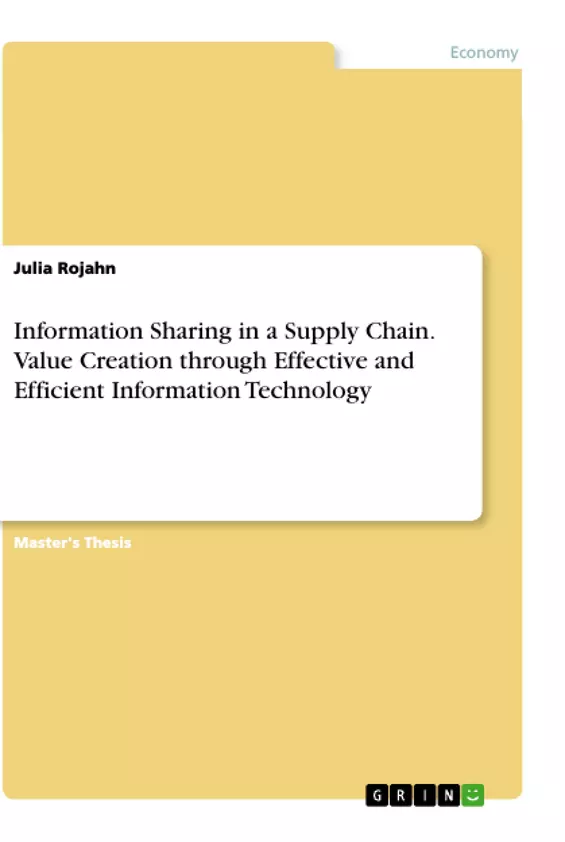The purpose of this study is to investigate and overview the effectiveness of IT in a SC in order to increase the value for a firm and efficiency in a manufacturing sector. It shall be analyzed how the implementation of a new information system can support value creation. However, before analyzing how IT impacts VC processes, it shall be identified, whether there actual is an impact. The aspect of how IS involved in the process of integrating new IT will be considered. Possible challenges and risks will determine an important issue as well. These steps will be supported by a single narrative case study, namely a Danish company, which operates in the manufacturing sector and which aims to increase the company’s value by implementing a new IT system. The company’s VC processes will be identified with regard to a VC analysis in order to detect possible relations between technology and value activities. These relations shall identify, whether there are linkages between technology and the process of value creation.
Inhaltsverzeichnis (Table of Contents)
- Introduction
- Purpose and research questions
- Design of the study
- Choice of theoretical background
- Choice of general methodology
- Research limitations
- Structure of the report
- Definitions of core terminology
- Theoretical Framework
- Market oriented view
- Literature Review
- Empirical design of the study
- Research approaches
- Research strategies
- The Case study
- Interview
- Grounded Theory
- Archival research strategy
- Validity and Reliability of empirical data
- The case study of XY A/S
- General facts about XY A/S
- Supply Chain of XY A/S
- Descriptive analysis
- Empirical findings
- Contingency Analysis
- Defining support and primary activities at XY A/S
- Linkages between TD and support activities
- Discussion
- Further research
- Recommendations for XY A/S
Zielsetzung und Themenschwerpunkte (Objectives and Key Themes)
This master thesis aims to examine the role of information sharing in a supply chain and how it contributes to value creation through the effective and efficient utilization of information technology. The study focuses on the specific case of XY A/S, analyzing its supply chain and identifying key areas where information sharing can be improved.
- Value creation through information sharing in supply chains
- Impact of information technology on supply chain performance
- Analysis of the XY A/S supply chain and its information sharing practices
- Identification of opportunities for improvement in information sharing within the XY A/S supply chain
- Recommendations for enhancing information sharing and value creation at XY A/S
Zusammenfassung der Kapitel (Chapter Summaries)
- The introduction establishes the purpose and research questions of the study. It outlines the design of the study, including the choice of theoretical background, general methodology, and research limitations. The chapter also details the structure of the report.
- This chapter defines key terminology used throughout the thesis, providing a framework for understanding the concepts of information sharing, supply chain management, and value creation.
- The theoretical framework section explores the concept of market-oriented view and provides a comprehensive literature review on information sharing in supply chains.
- Chapter 3 outlines the empirical design of the study, including the research approaches, strategies, and methods employed. The chapter also addresses the validity and reliability of the collected data.
- The case study of XY A/S is presented in this chapter, including general information about the company and a detailed analysis of its supply chain.
- This chapter presents the descriptive analysis of the empirical findings, highlighting key observations and insights gathered from the study.
- The contingency analysis focuses on defining support and primary activities at XY A/S and explores the linkages between technology development and these activities.
- The discussion chapter delves into the key findings of the study and explores potential avenues for further research. The chapter also offers recommendations for XY A/S to enhance its information sharing practices and improve value creation within its supply chain.
Schlüsselwörter (Keywords)
This study focuses on information sharing, supply chain management, value creation, information technology, and the application of these concepts within the context of a specific case study, XY A/S. The thesis analyzes the relationship between information sharing and supply chain performance, examining how information technology can be leveraged to optimize value creation within a supply chain. The study explores the specific challenges and opportunities associated with information sharing at XY A/S and offers actionable recommendations for improving its information sharing practices.
- Quote paper
- Julia Rojahn (Author), 2017, Information Sharing in a Supply Chain. Value Creation through Effective and Efficient Information Technology, Munich, GRIN Verlag, https://www.grin.com/document/1141793



